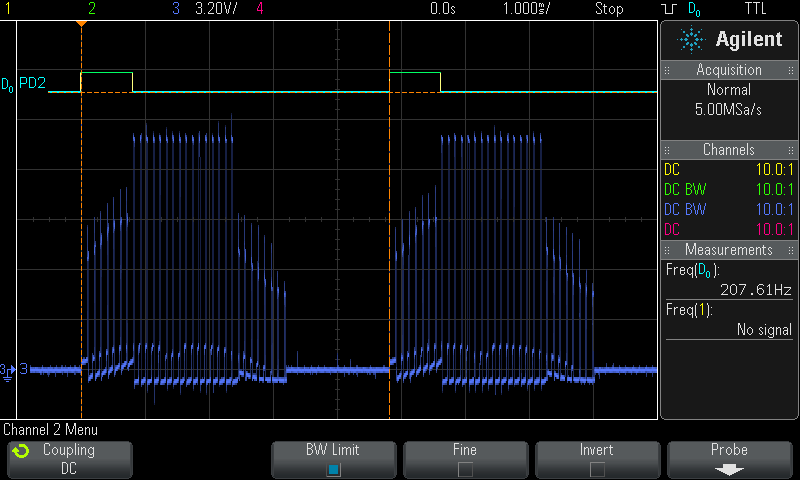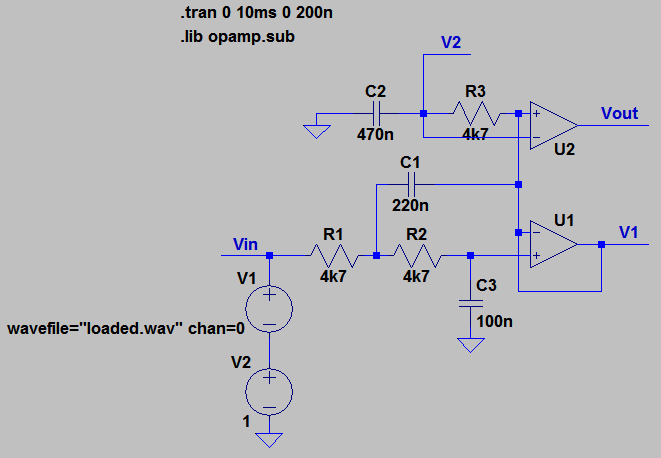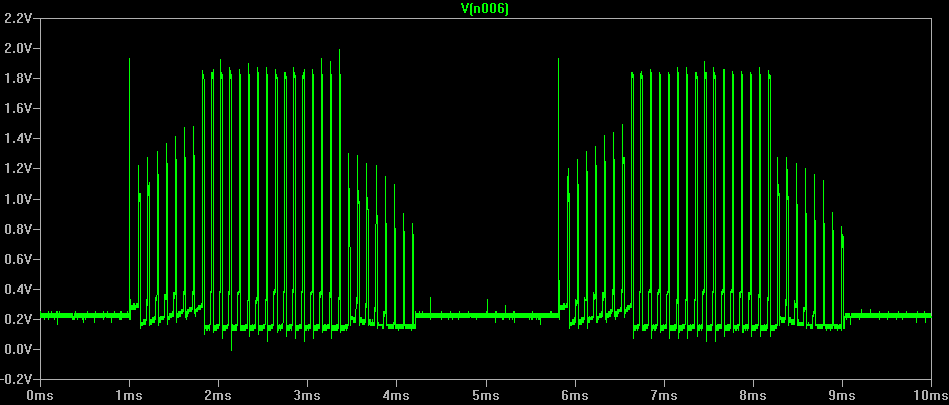Ltspice
From Attie's Wiki
Contents |
Using a captured waveform as LTspice input
This outlines the steps necessary to use a CSV file as input for LTspice.
Capture your waveform
I have captured the following waveform using my scope, and saved it as a CSV file.

A sample of the CSV file is shown below:
x-axis,3,D0-D7 second,Volt, -1.0000000E-03,-48.2407212E-03,0 -999.8000E-06,-48.2407212E-03,0 -999.6000E-06,-48.2407212E-03,0 -999.4000E-06,-48.2407212E-03,0 - - - - - - - - >8 - - - - - - - - +8.9990000E-03,-168.8437350E-03,0 +8.9992000E-03,-176.8839359E-03,0 +8.9994000E-03,-48.2407212E-03,0 +8.9996000E-03,-48.2407212E-03,0
Convert the CSV file to an 8-bit wav file
Use the script below. There are a few configuration options:
| Option Name | Description |
|---|---|
| CSV_FILE | The source CSV file |
| CSV_COLUMN | The column of the CSV file that you'd like to extract |
| SAMPLE_RATE | The rate that the samples were stored at, in Hz |
| ROOT_FILENAME | (optional) If you want to store the output somewhere else, then change this |
#!/bin/bash -e CSV_FILE=loaded.csv CSV_COLUMN=2 SAMPLE_RATE=5000000 ROOT_FILENAME=${CSV_FILE%.*} # end of configuration cat ${CSV_FILE} \ | tail -n+3 \ | cut -d , -f ${CSV_COLUMN} \ | sed -r \ -e 's/^\+//' \ -e 's/^(-?[0-9]+\.[0-9]+)[eE]([+-])([0-9]+)$/\1*(10^\2\3)/' \ -e 's/\*\(10\^\+00\)$//' \ | bc -l \ | sed -re 's/^(-?)\./\10./' \ | tee .${CSV_FILE}.normal \ | sort -n \ | uniq \ > .${CSV_FILE}.sorted cat .${CSV_FILE}.sorted | sed -n "1p;$(wc -l .${CSV_FILE}.sorted | cut -d ' ' -f 1)p" > .${CSV_FILE}.extremes LO=$(cat .${CSV_FILE}.extremes | head -n 1) if [ $(echo "${LO} < 0" | bc) == "1" ]; then OP=- else OP=+ fi HI=$(echo "($(cat .${CSV_FILE}.extremes | tail -n 1))${OP}(${LO})" | bc -l) ML=$(echo "255/${HI}" | bc -l) cat .${CSV_FILE}.normal \ | sed -r \ -e 's/^/((/' \ -e 's/$/)/' \ -e "s/$/${OP}(${LO})/" \ -e "s/$/)*${ML}/" \ | bc -l \ | sed -r \ -e 's/^([0-9]*).([0-9]?[0-9]?[0-9]?).*$/\1.\2/' \ | tee .${CSV_FILE}.adjusted \ | awk '{printf "%c", strtonum($0)}' \ > ${ROOT_FILENAME}.raw DATA_SIZE=$(stat -c%s ${ROOT_FILENAME}.raw) CHUNK_SIZE=$((DATA_SIZE + 36)) WAV=${ROOT_FILENAME}.wav # writeNumAsBin # arg1: bytes used to represent the word # arg2: value stored in the word function wnab() { WORD_SIZE=$1; shift WORD_VALUE=$1; shift printf "%0$((WORD_SIZE * 2))x" ${WORD_VALUE} \ | fold -w2 \ | sed '1!G;h;$!d' \ | awk '{printf "%c", strtonum("0x" $0)}' } # ChunkID echo -n "RIFF" > ${WAV} # ChunkSize wnab 4 ${CHUNK_SIZE} >> ${WAV} # Format & Subchunk1ID echo -n "WAVEfmt " >> ${WAV} # Subchunk1Size wnab 4 16 >> ${WAV} # AudioFormat wnab 2 1 >> ${WAV} # NumChannels wnab 2 1 >> ${WAV} # SampleRate wnab 4 ${SAMPLE_RATE} >> ${WAV} # ByteRate wnab 4 ${SAMPLE_RATE} >> ${WAV} # BlockAlign wnab 2 1 >> ${WAV} # BitsPerSample wnab 2 8 >> ${WAV} # Subchunk2ID echo -n "data" >> ${WAV} # Subchunk2Size wnab 4 ${DATA_SIZE} >> ${WAV} # data! cat ${ROOT_FILENAME}.raw >> ${WAV}
Useful resources:
Feed into LTspice
You'll need a voltage source (like always), but instead of providing a DC voltage, you should enter the following:
wavefile="loaded.wav" chan=0
Here is a sample sallen-key & comparator circuit that I'm testing out for my quadcopter:

When you now run the simulation, you'll get a nice output like this (probing Vin):

Setting the initial voltage of a net
This is useful, for example when you have a passive low-pass filter, you can set the initial state of the capacitor, and that can reduce the amount that you have to simulate.
- Name the net, for example "V1" (press F4)
- Add a spice directive ".ic V(V1)=0.333" to set the voltage to 333mV (press s)